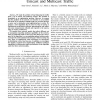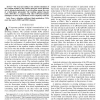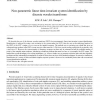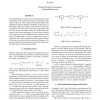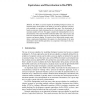APIN
2000
14 years 7 months ago
2000
Genetic algorithms are adaptive methods based on natural evolution that may be used for search and optimization problems. They process a population of search space solutions with t...
TON
2008
14 years 7 months ago
2008
We study the problem of load balancing the traffic from a set of unicast and multicast sessions. The problem is formulated as an optimization problem. However, we assume that the g...
TCOM
2008
14 years 7 months ago
2008
The step size leading to the absolute minimum of the constant modulus (CM) criterion along the search direction can be obtained algebraically at each iteration among the roots of a...
JMLR
2006
14 years 7 months ago
2006
This paper presents an online support vector machine (SVM) that uses the stochastic meta-descent (SMD) algorithm to adapt its step size automatically. We formulate the online lear...
DSP
2006
14 years 7 months ago
2006
We describe the use of the discrete wavelet transform (DWT) for non-parametric linear time-invariant system identification. Identification is achieved by using a test excitation t...
WCNC
2010
IEEE
14 years 11 months ago
2010
IEEE
A new adaptive algorithm, called LLMS, which employs an array image factor, IA , sandwiched in between two Least Mean Square (LMS) sections, is proposed for different applications ...
GECCO
2004
Springer
15 years 25 days ago
2004
Springer
Using a directed mutation can improve the efficiency of processing many optimization problems. The first mutation operators of this kind proposed by Hildebrand [1], however, suffer...
ICMCS
2006
IEEE
15 years 1 months ago
2006
IEEE
Bit rate adaptation is one of the most important types of video transcoding. With H.264 becoming the predominant video codec of choice in video coding and streaming, prudent ratea...
CMSB
2009
Springer
15 years 2 months ago
2009
Springer
Bio-PEPA is a process algebra for modelling biological systems. An important aspect of Bio-PEPA is the ability it provides to discretise concentrations resulting in a smaller, more...
ICPR
2006
IEEE
15 years 8 months ago
2006
IEEE
An often overlooked problem in matching lies in selecting an appropriate step size. The selection of the step size for real-time applications is critical both from the point of vi...

